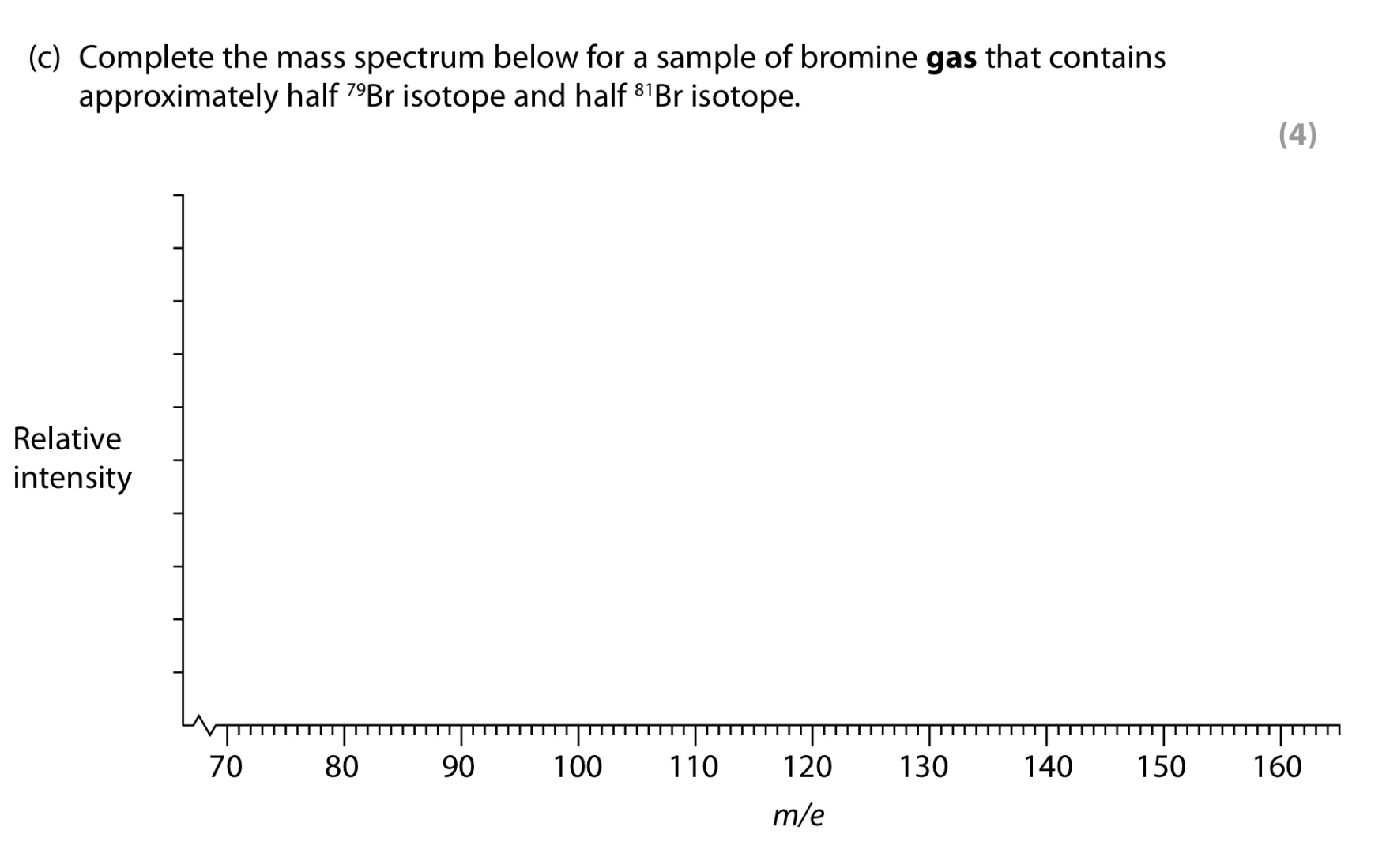Need HELP with drawing the mass spectra graph!!!
I drew the lines for 79 and 81 only but I don't know how tall they should be or their % abundance!

the % abundance for each isotope will be 50% as half is one isotope and the other half is the other isotope

Original post by fgardhouse
the % abundance for each isotope will be 50% as half is one isotope and the other half is the other isotope

Is it always the same case for every isotope or just this one?
it isn't always the same but in the question it says that halve the sample is 79-Br and the other halve is 81-Br
Original post by Adorable98
Is it always the same case for every isotope or just this one?
Just this one.
The height of the signal is directly proportional to the natural abundance of the isotope ...
Original post by charco
Just this one.
The height of the signal is directly proportional to the natural abundance of the isotope ...
The height of the signal is directly proportional to the natural abundance of the isotope ...
I see, so this is the markscheme. How do I know the heights of 158, 160 and 162?!
Original post by Adorable98
I see, so this is the markscheme. How do I know the heights of 158, 160 and 162?!

This is statistics.
If you have two isotopes with equal probability and diatomic molecules then there are three possible masses for the molecules, 158, 160 and 162:
But there is twice as much chance (probability) of the molecule being 160
79Br79Br = 158
79Br81Br = 160
81Br79Br = 160
81Br81Br = 162
Hence the signal for 160 is twice as high ...
Original post by charco
This is statistics.
If you have two isotopes with equal probability and diatomic molecules then there are three possible masses for the molecules, 158, 160 and 162:
But there is twice as much chance (probability) of the molecule being 160
79Br79Br = 158
79Br81Br = 160
81Br79Br = 160
81Br81Br = 162
Hence the signal for 160 is twice as high ...
If you have two isotopes with equal probability and diatomic molecules then there are three possible masses for the molecules, 158, 160 and 162:
But there is twice as much chance (probability) of the molecule being 160
79Br79Br = 158
79Br81Br = 160
81Br79Br = 160
81Br81Br = 162
Hence the signal for 160 is twice as high ...
So if the question lets say was about Carbon for instance, do you work it out in the same way, so
C12 x C12
C13 x C13
C14 x C14
C12 x C13
C13 x C14
C12 x C14
C12 x C13 x C14
Original post by Adorable98
So if the question lets say was about Carbon for instance, do you work it out in the same way, so
C12 x C12
C13 x C13
C14 x C14
C12 x C13
C13 x C14
C12 x C14
C12 x C13 x C14
C12 x C12
C13 x C13
C14 x C14
C12 x C13
C13 x C14
C12 x C14
C12 x C13 x C14
Carbon cannot make diatomic molecules ..
It gets more complicated when the natural abundance of each isotope is not 50%.
In chlorine for example the ratio of heights for Cl2 is 9:6:1, for 70, 72 and 74 respectively
Original post by charco
Carbon cannot make diatomic molecules ..
It gets more complicated when the natural abundance of each isotope is not 50%.
In chlorine for example the ratio of heights for Cl2 is 9:6:1, for 70, 72 and 74 respectively
It gets more complicated when the natural abundance of each isotope is not 50%.
In chlorine for example the ratio of heights for Cl2 is 9:6:1, for 70, 72 and 74 respectively
How did you get the ratio?!
Original post by Adorable98
How did you get the ratio?!
It's statistical probability.
The natural abundances are 75% 35Cl and 25% 37Cl
Hence the probability of a molecule containing two 35Cl atoms is 3/4 x 3/4 = 9/16
the probability of a molecule containing two 37Cl atoms is 1/4 x 1/4 = 1/16
Hence the probability of a molecule containing one 35Cl atom and one 37Cl atom is 16/16 - (9/16 + 1/16) = 6/16
Hence the ratio is 1:6:9 with respect to m/z 74:72:70
Quick Reply
Related discussions
- BTEC applied science unit 19
- NMR- drawing and labelling spectra.
- Chemistry A level,mass spectrometry questions
- AQA A Level Physics Paper 2 7408/2 - 10 Jun 2022 [Exam Chat]
- Any help on these two GCSE questions very much appreciated
- Undergraduate chemistry
- chem question
- AQA a level physics question - beta minus decay
- Electrical Engineering maths help with Desmos graphing calculator
- How to re-attempt graph sketches in the GCSE.
- Edexcel A-Level Chem Paper 2 Advanced Organic and Physical Chemistry [Exam Chat]
- OCR A A-level Physics Paper 1 Modelling Physics (H556/01) - 24th May 2023 [Exam Chat]
- AQA A Level Chemistry Paper 3 20th June 2018 Unofficial Markscheme
- AQA A Level Physics Paper 1 7408/1 - 26 May 2022 [Exam Chat]
- is it just me or is this question incomplete??
- How to improve graph interpretations in Biology?
- Can anyone answer this GCSE cubic graph question??
- Physics AS June 2021 Q3.3
- Edexcel A Level Physics Paper 3: 9PH0 03 - 15th June 2023 [Exam Chat]
- Applied Science Unit 3 investigation skills
Latest
Trending
Last reply 1 week ago
Im confused about this chemistry question, why does it form these productsTrending
Last reply 1 week ago
Im confused about this chemistry question, why does it form these products



